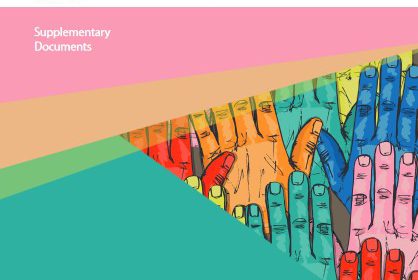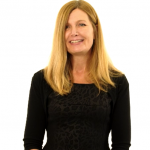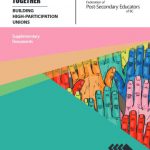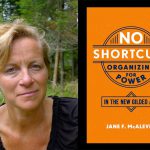
Member Voice: FPSE AGM, 2017
 Guest blogger: Laurie Izgerean, BCITFSA PTS Task Force, PTS Communications Faculty
Guest blogger: Laurie Izgerean, BCITFSA PTS Task Force, PTS Communications Faculty
What: 47th AGM and Convention – Federation of Post Secondary Educators of BC (FPSE)
Theme: Stronger Together: Building High-Participation Unions
When: May 15-17, 2017 – Victoria B.C. (Day 1 & 2 Only)
Opening Session – Day 1 Recap
 President’s Message: The 47th Annual FPSE AGM kicked off with a BC election recap of the largest campaign in their history – The Open the Doors campaign. “It started in 2014 as a response to the BC government’s Skills for Jobs Blueprint and its plans to re-engineer post-secondary education,” and although the outcome of their efforts won’t be known until post-recount and absentee ballot count, an analysis will follow post election results. Their first ever TV ad was viewed by over 5 million British Columbians. A promise was made to hold the BC Government accountable to election promises regardless of who ‘wins’ as there is less than 2 years before they are back at the bargaining table. Other campaign highlights include:
President’s Message: The 47th Annual FPSE AGM kicked off with a BC election recap of the largest campaign in their history – The Open the Doors campaign. “It started in 2014 as a response to the BC government’s Skills for Jobs Blueprint and its plans to re-engineer post-secondary education,” and although the outcome of their efforts won’t be known until post-recount and absentee ballot count, an analysis will follow post election results. Their first ever TV ad was viewed by over 5 million British Columbians. A promise was made to hold the BC Government accountable to election promises regardless of who ‘wins’ as there is less than 2 years before they are back at the bargaining table. Other campaign highlights include:
- 18,000 pledges of support delivered to the Official Opposition
- 3-Telephone Town Halls with over 200,000 calls made
- 207,000-member audience on Open the Doors Facebook page with over 11,000 interactions
There was mention of the upcoming Collegial Governance Conference to be held this Fall 2017 – first time since 2010. An increase of faculty participation within government structures will be the focus.
In addition to Fair Employment Week and Truth and Reconciliation projects, and an emphasis on bargaining included the ongoing frustration of dealing with the Liberal Party since 2001 and the inadequate government M.O. of ‘why negotiate when you can legislate.’
In keeping with the ‘stronger together’ theme, an appropriate segue to guest speaker Jane McAlevey focused on the importance of organizing efforts and activities to build union density, grow new membership, and insure everyone has a voice.
 Keynote Speaker: Jane McAlevey: Is an organizer, author and scholar. Her first book, Raising Expectations (and Raising Hell), published by Verso Press, was named the ‘most valuable book of 2012” by The Nation Magazine. She has led power structure analyses and strategic planning training for a wide range of union, community, and environmental organizations and has had extensive involvement in globalization and global environmental issues. She is currently a Post Doc with the Labor and Worklife Program at the Harvard Law School (AGM 2017 Handbook).
Keynote Speaker: Jane McAlevey: Is an organizer, author and scholar. Her first book, Raising Expectations (and Raising Hell), published by Verso Press, was named the ‘most valuable book of 2012” by The Nation Magazine. She has led power structure analyses and strategic planning training for a wide range of union, community, and environmental organizations and has had extensive involvement in globalization and global environmental issues. She is currently a Post Doc with the Labor and Worklife Program at the Harvard Law School (AGM 2017 Handbook).
One key powerful insight from her presentation was the focus on high participation as a prerequisite to union power. She acknowledged the Occupy Movement and its ability to create an effective slogan – The 99% – but the real power lies in the ability to organize and mobilize the 99% towards action. The rest of her talk focused on the four core concepts of building strength beyond the union dues and towards full participation strikes.
Structural Organization vs. Self Selecting Organization: For a structural organization like a union to build its membership it must encourage and engage new membership, not rest on the laurels of the already converted. A self-selecting organization (sub-groups) typically consist of those already on-side and in favour of the group’s goals.
Leaders vs. Activists: Activists are current members and don’t ‘build’ a union. An organic leader, on the other hand, is someone who holds and commands the respect of their peers, they may have a title or they may no, and many don’t ant or hold an official position. However, these people help to focus energy on the undecided – the folks not yet committed to union goals – and they have the ability to both identify and recruit supporters.
Whole Workers vs. Community Labor Alliance: “Whole-worker organizing begins with the recognition that real people do not live two separate lives, one beginning when they arrive at work and punch the clock and another when they punch out at the end of their shift. The pressing concerns that bear down on them every day are not divided into two neat piles, only one of which is of concern to unions. At the end of each shift workers go home, through streets that are sometimes violent, past their kids’ crumbling schools, to their often-substandard housing, where the tap water is likely unsafe. This is different from building a “labor-community alliance,” which typically involves unions as institutions looking for institutional allies in the community. Instead, unions must recognize that their members, or the people they seek as members, are part of the community; they do not draw a hard line between their existence as workers and their existence as parents, spouses, tenants, etc. (Raising Hell for Labor, Downs/McAlevey, 2016)
Organizing vs. Mobilizing: “[It’s a] problem when we’re doing just a mobilizing model: all we’re doing is talking to the already-convinced and we’re not doing base expansion. Real organizing is about focusing on people who are not yet convinced and not yet involved in our movement.
Jane’s books are available in hard cover, soft cover and Kindle versions.
- Raising Expectations (and Raising Hell): My Decade Fighting for the Labor Movement
- No Shortcuts: Organizing for Power in the New Gilded Age
Plenary Session – Day 2
 Guest Speaker: Aaron Ekman: Day two began with the Secretary-Treasurer of the BC Federation of Labour. “Ekman was the founding president of the North Central Labour Council, representing more than 12,000 union members across northern BC, and previously worked as a union organizer (BCFED). He has a long history of progressive political campaigning at the local, provincial and federal government levels” (BCFED). He pulled no punches when he referenced the billions of dollars in over-runs at Site C all while the abuse of public services and the slashing of education funding by the Liberal government runs rampant. This met with rousing applause and cheers from a room full of 300+ people. Aaron’s passionate commentary of the current lay-of-the-land focused on corporate interest over the needs of the public.
Guest Speaker: Aaron Ekman: Day two began with the Secretary-Treasurer of the BC Federation of Labour. “Ekman was the founding president of the North Central Labour Council, representing more than 12,000 union members across northern BC, and previously worked as a union organizer (BCFED). He has a long history of progressive political campaigning at the local, provincial and federal government levels” (BCFED). He pulled no punches when he referenced the billions of dollars in over-runs at Site C all while the abuse of public services and the slashing of education funding by the Liberal government runs rampant. This met with rousing applause and cheers from a room full of 300+ people. Aaron’s passionate commentary of the current lay-of-the-land focused on corporate interest over the needs of the public.
The rest of the early morning session prior to first break included:
- President’s Report on Action Resolutions of the 2016 AGM
- Secretary-Treasurer’s Report
- Vice-President’s Report
- Members-at-Large Reports
- Call for Nominations
The post-break plenary session kicked off with the Open the Doors campaign highlight reel that illustrated the campaign’s purpose: To reverse the underfunding of public school education in B.C. As an aside, it was a proud moment when the BCITFSA logo was captured in the “Thanks for your support” section of the video. The rest of the session included;
- Auditors Report
- Ratification of Policy Resolutions from President’s Council 2016/2017
- Strategic Goals 2017/2018
- Special Resolutions: Constitutional and By-Law Amendments
- Second Call for Nominations
Day 2: Workshops Available:
- Media Relations: Sage Aaron, Communications Director, MoveUp
- Mental Health and Addictions: Jonathan Chapnick, Workplace Mental Health, UBC
- Retirement Readiness Begins Now: Kathy Conroy, Retired Appointee, FPSE PAC
- Communications + Engagements = Stronger Unions: Kyla Epstein, Member Engagement Officer, BCITFSA
- Organizing: Sean Hillman, Zoe Towle, Labour Relations Staff Reps FPSE
- Unions and Communities: Building Coalitions: Nikki Hill, Labour Participation, United Way
Day 2: Workshops Attended
Truth, Reconciliation and the Role of the University: Jacqueline Romanow, Chair, Dept. of Indigenous Studies, University of Winnipeg
Since the release of the Final Report and Calls to Action of the Truth and Reconciliation Commission (2015), post-secondary institutions across Canada have been challenged with the task of meaningful response. This workshop examined the various responses to the Calls to Action and assesses how they may, or may not facilitate meaningful reconciliation between Canada’s indigenous and non-indigenous populations (AGM 2017 Handbook)
Note: Ms. Romanow was a compelling and credible speaker as a proud Metis woman who can speak with a first-person account of how this topic plays out within her community and within her personal and professional life. “Truth means understanding Canada was created out of genocide, and reconciliation means equity, not pity.” The title slide of her presentation reiterated this theme: Truth & Reconciliation in Canada’s Post Secondary Institutions: Not just sympathy or nice words.
This struck a chord with the audience while reflecting upon the number of post-secondary faculty who are ‘experts in Indigenous studies but have no idea what it’s like to be indigenous.’ She was instrumental in the creation and implementation of the mandatory Indigenous course requirement at the University of Winnipeg. UWinnipeg is one of the first universities in the country to mandate that all students have a baseline knowledge about Indigenous people and culture. Approved in November 2015 by the University’s Senate, the new Indigenous Course Requirement (ICR) makes Indigenous learning part of the undergraduate degree requirements for all new UWinnipeg students, beginning in the fall of 2016. She also developed the Master of Arts Program in Indigenous Governance.
Solidarity through Intersectionality: Building Bridges Among Different Groups of Women
Cultural awareness is vital to the work that we all do as activists. This workshop too a three-dimensional view through the lens of intersectionality, to discuss ways in which activists can participate in productive and meaning conversations on equity and inclusion. Participants were encouraged to learn through self-reflection and listening (AGM 2017 Handbook).
Note: Informative handouts included common behavioural patterns that perpetuate power imbalances between positions of privilege and oppression, and 10 key points for becoming a more compassionate activist:
- Work towards what we are for, not just what we are against
- Compassion is rooted in an understanding of the connection between all living beings
- Learn to act rather than react
- The ends do not justify the means
- Don’t put people down – raise each other up
- It’s only an opinion – be willing to change your mind
- Be a peacemaker
- Learn to listen to your heard, not just your mind
- It’s all about process
- Be mindful
Final Thoughts
I was thrilled when provided with an opportunity to represent the BCITFSA as a formal guest at the 27th FPSE AGM – especially since I was completely unfamiliar with the inner workings of a union and its executive membership. My previous professional career in Canada’s automotive industry was spend on the non-union side, and neither of my parents nor any family member was ever associated with one. Even though I gladly pay my dues each pay, and enjoy the comfort of knowing I am represented by a good one as a PTS Instructor at BCIT, I had a limited understanding about the depth and breadth of worthwhile endeavours those dues support. I am excited at what lies ahead in my role as a BCITFSA PTS Task Force Member, and I look forward to representing us at the CAUT Contract Academic Staff Conference in Toronto in October.
Leave a reply →